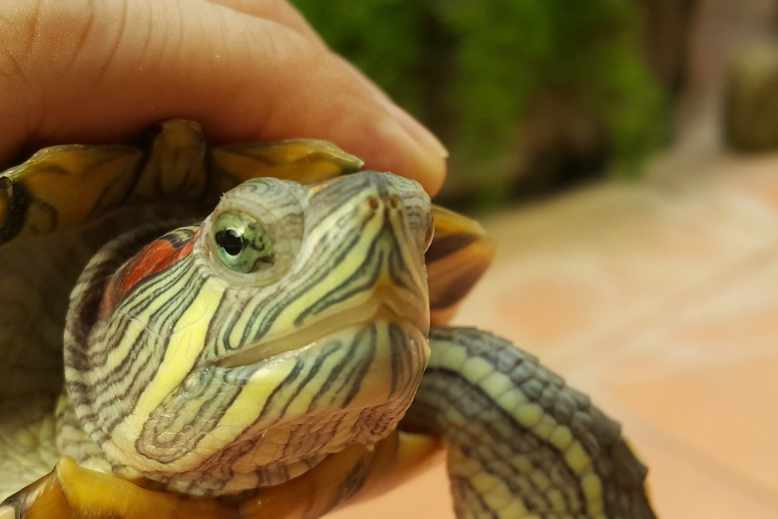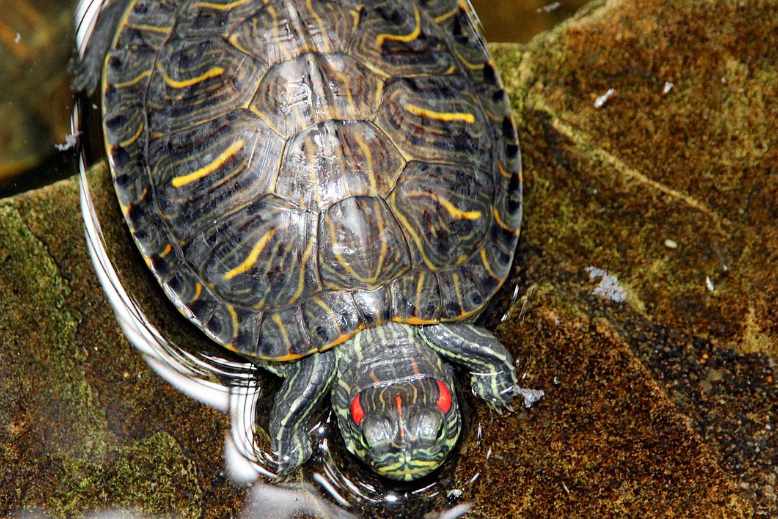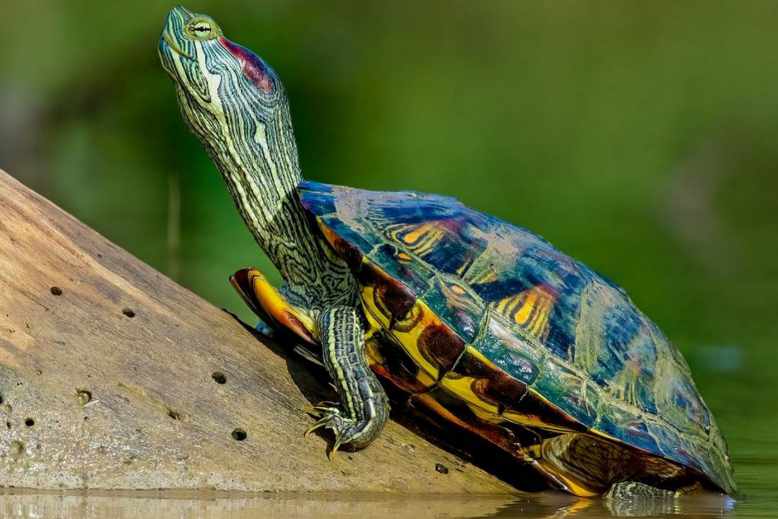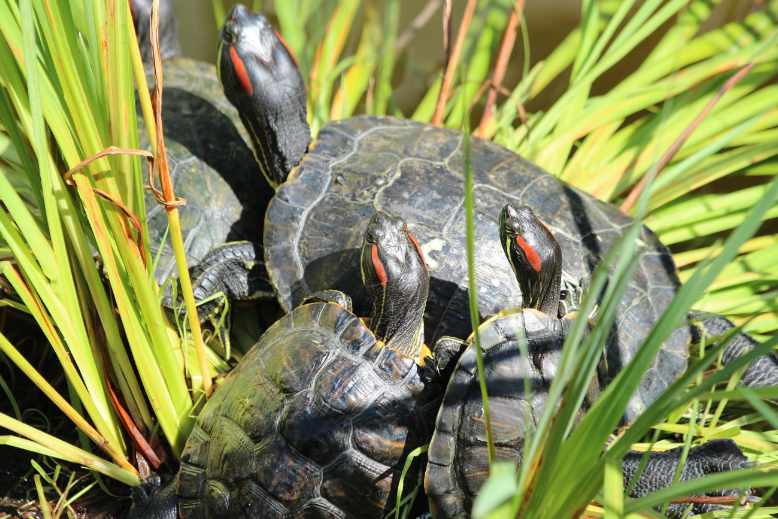Red-eared slider water temp (Ideal expert recommendation). The ideal water temperature recommendation for a red-eared slider is around 72°F-76°F while the basking area temperature for Red-eared sliders should lie between 85°F-95°F. Sliders are ectothermic animals which means they rely on their external environment to regulate their body temperatures. As a result, a water temperature of 65°F to 72°F or below can cause some severe health concerns for your cold-blooded pet. At a temperature below 50 degrees Fahrenheit, the cold becomes intolerable for red-eared sliders.
It is a fact that sliders are amongst the most entertaining and rewarding reptile pets you could ever ask for. But with a lifespan of 20-30 years in captivity, they are a serious commitment. Red-eared sliders are amongst the easiest to keep reptiles, but they have definite temperatures, environmental, and nutrition requirements and require a lot of constant care.
As a potential owner, it is good to be aware of red-eared slider water temp requirements to ensure your pet lives a happy and healthy life for many years. So if you are a fan of this shy but amazing pet, we suggest you keep on reading to find out red-eared slider water temp and basking requirements.
Red Eared Slider Water Temp

Red-eared turtle water temp is essential to its overall health. In the wild, these cold-blooded reptiles prefer waters that quickly warms up. Sliders need a water temperature between 72 to 76 degrees Fahrenheit for good health.
Low water temperatures can cause severe health concerns or even the death of your beloved reptile pets. Therefore, your slider’s water pond or tank must maintain these temperatures all the time. To adjust just the right temperature, we suggest investing in thermometers to keep track of water temperature and make sure it is in a safe range.
If you live in an environment where the temperature drops quickly, you might want to set up a water heater in your tank or pond. But keep in mind pond heaters are not as accurate as tank heaters, and you will need to check the temperature manually. Owners should also avoid the de-icing type of floating pond heaters as they don’t heat the water to the bottom. As a result, sliders are likely to swim towards the floating heater, possibly injuring themselves.
Here we have some red-eared slider water temp requirements:
- Hatchlings or sick red eared sider water temp requirements
For hatchlings or sick sliders, it’s best to maintain a few degrees higher water temperature than healthy sliders. The water temperature between 78°f-82°f helps hatchlings and sick sliders grow and recover from their diseases easily by keeping their metabolism healthy. However, check the temperature frequently to know if it’s too hot. The purpose is to provide warmth, not to boil.
- Adult red-eared slider water temp requirements
Healthy adult red eared sliders require a water temperature of 72°f-76°f to maintain an active and healthy metabolism. Low temperatures make their metabolism slow down, and the turtle will stop eating. Too high temperatures can cook your slider, and you will lose a stupendous pet! So turtle lovers, you better grab a good aquarium thermometer to keep an eye on the temperatures.
Red-eared turtle water temp maintenance

If you have a red-eared slider tank in your house and the temperature remains around 75°F, then it is fine. If the situation is different, you may have to invest in a water heater for your slider tank. Water heaters prevent the temperature from falling too low during the cold times by providing some extra warmth.
It is important to understand that if the temp falls below 60°F, sliders can end up getting some disease. Slider owners should also keep in mind that heating pads, sunlight, and basking lights are not the most effective ways to raise the water temperature of their red-eared slider tank.
- How to measure water temperature of a red eared slider tank?
You can easily measure the temperature of your slider turtle tank with a thermometer to make sure it isn’t freezing or boiling. Sliders may mess with the thermometer if it is left in water. So only dip the probe in the tank or pond for occasional measurements. Once you are done taking readings, remove the thermometer again.
- How to heat the red eared slider tank water?
If you wish to heat the water tank, start by setting the heater to a minimum temperature. It will help you maintain a diversity of variations in the temperature gradient.
If your tank water gets warmer than the maximum limit (more than 76°f for adult sliders), you will need to cool the water to sustain a safe temperature. Fortunately, water getting too hot without a water heater is pretty rare.
By this point, you already know that water heaters are important to maintain a warm atmosphere. But that doesn’t mean you should grab any heater from your nearest pet accessory store. Pick a water heater that:
- Is encased in protective plastic. Such heaters prevent direct contact, thus reducing the risk of slider injuries.
- Is recommended by experienced turtle keepers for the maximum gallons of water in your tank.
- Has an automatic shutdown feature.
Some water heaters don’t come with protective plastic. But you have to install these heaters with plastic covers to prevent your lovely slider from getting burned.
Red Eared Slider Basking Temperature

Sliders are semiaquatic in their natural habitat. It means these turtles spend most of their time in the water. But they do require a moderate time in the sun (basking) to dry off and warm up. While basking may look to you as if your slider is just having a good time in the sun, it’s actually quite beneficial for your pet’s overall health.
Some basking advantages include:
- Shedding assistance
- Egg incubation
- Immune function
- Vitamin D3 synthesis
- Hormonal regulation
- Shell and skin health
- Digestion
- Fighting off disease
- Parasite management
- Metabolism
- Wound healing
- And more!
Sliders need both water and land to thrive in captivity. However, their temperature requirements for each space are different. Slider turtles require an 80 to 90°F basking temperature, while the air temperature should lie between mid-70 to 80°f.
Use a digital thermometer to measure the basking area temperature. Temperature measurement should be taken a few hours after the basking rock has warmed up.
- How to heat the basking area?
Your sliders need just the right basking area temperatures to survive. If the temperature is too high, sliders tend to stay away from the basking area to prevent burning. If the temperature is below average, sliders can get a respiratory infection which can be fatal.
You can use a basking bulb to warm up your red-eared slider thoroughly. Furthermore, it is also recommended to set up a UVB/UVA light in the slider enclosure to encourage basking. Exposure to ultraviolet light is important for calcium metabolism. Plus, it offers some other health advantages such as improved appetite, reduced algae growth, and more.
Many reptile owners make the mistake of placing their slider turtle tank in a place where there is a lot of natural sunlight. And no doubt, it seems like a pretty tempting solution for the UV Ray problem. But unfortunately, this isn’t the solution!
Most glass and plastic aquariums filter out the UVB rays, making it impossible for your slider to benefit from your aquarium placement. That’s why you need to opt for a UVB-producing light bulb. These bulbs use special glasses to allow the rays to pass through.
If you live in an area where the sun shines most of the time, you can bring your slider out for natural sunbathing. It will help the turtle to satisfy its UVB requirements. But be alert! Bringing your slider outside makes the fellow an easy prey for other animals. Moreover, if there isn’t enough shade, your slider can overheat, which can be fatal.
- Temperature and Heat Maintenance
Once you have selected your heating source, the next level is to make effective use of it. You need to make sure you have the right temperature range, and the lightning is focused at the center of the basking area. This allows your red-eared slider to move closer or further from the heating source.
Too cold temperature for red-eared sliders

Just like many other reptile species, red-eared sliders find it difficult to endure cold temperatures. They require a healthy temperature of 72 to 76°f in captivity. If the temperature drops down, it becomes too cold for them to perform their usual activities, so they brumate.
Usually, the temperature below 50°F or 10°C is the brumating temperature for red-eared sliders. Brumation is a lighter version of hibernation. Brumating animals are slightly more active than hibernating ones.
Sliders reduce almost 80% of their metabolism and heart rate during the brumation state to prevent energy consumption. They brumate to survive during cold temperatures. So if the temperature of your enclosure falls below 70 degrees Fahrenheit, your slider will start the brumation process. The pet will lay at the bottom of the water source available in your enclosure and play dead. Sliders usually brumate for 3 to 4 weeks, but they do come out for basking from time to time.
As a responsible red-eared slider owner, you need to take the necessary steps to provide your sliders with the required heat unless you want them to brumate.
What happens to a red-eared slider if the temperature is too low?
As mentioned earlier, these lovely pets are ectothermic species. It means without any external heating source, they cannot regulate their body temperature. So when the temperature falls below, sliders go through some physical changes, including:
- The slider will not defecate.
- They can experience respiratory infections.
- Your pets may not stop drinking, but they will stop eating.
- Sliders go into a state of extremely low metabolism rate, which can threaten their health.
- Sliders will experience slow cardiac outputs, and the heartbeat rate will reduce.
- If the cold prolongs, your pets can either brumate or decease.
Can red eared sliders survive too low temperature?
To some extent, yes, they can!
In the wild red-eared sliders hibernate to survive the cold atmosphere. Wild ones have extended their ability to deal with the freezing temperatures, so they are pretty tough. But for captive sliders, the temperature shouldn’t be an issue. You can easily install a water heater to regulate the temperature.
What temperature is too hot for your red-eared slider?
Well, this depends on the intensity of the temperature and slider. However, temperature above 80-degree Fahrenheit for water and 95 degrees Fahrenheit for basking spots is too high for a healthy and adult red-eared slider.
If the temperature is too hot, the slider may prefer to spend more time in water and avoid basking, which is extremely harmful because lack of basking causes fungal infections and gives rise to other common health conditions.
Important heat and light considerations
Before going any further, let’s have a look at some general slider turtle tank guidelines:
- Always prefer a UV light source that offers both UVB and UVA rays.
- Never put your red-eared slider in a small aquarium that doesn’t have any basking spot. You don’t want misery for your amazing pet.
- Steer clear of temperature requirements. No doubt red-eared sliders are vigorous, but that doesn’t mean they cannot get sick at all.
- Never opt for a UV light source with less than 5 to 10% UV-b rays. It won’t satisfy your slider’s basic UV-b needs.
- Place the heating lamp in a way that maintains 85-to-90-degree basking area temperature.
- Only consider using a water heater if the temperature is too low. You may want to select a submersible water heater as they work well and are pretty affordable.
- Say no to water heaters without protective covering to prevent injuries.
- You can take the slider out in the sun but beware of the predators. Also, make sure the pet doesn’t overheat.
- Choose the best quality heater to maintain the right temperature. Don’t forget to monitor the temperature with a thermometer.
Wrapping up
To raise a happy and healthy pet, you need to understand a red-eared slider turtle’s temperature needs and living requirements. It is crucial to provide a balanced temperature so the lovely pet can thrive in an optimal living environment.
